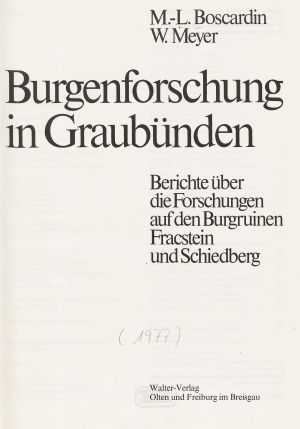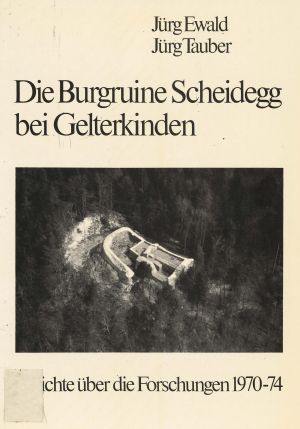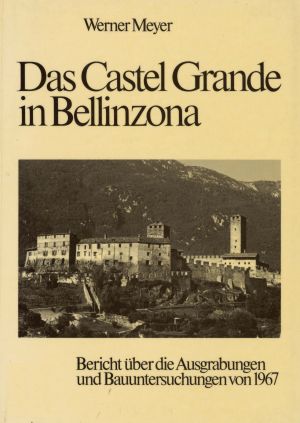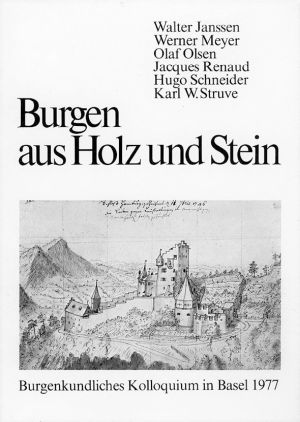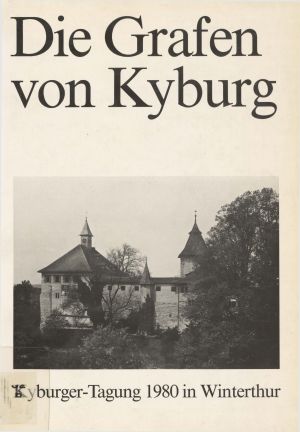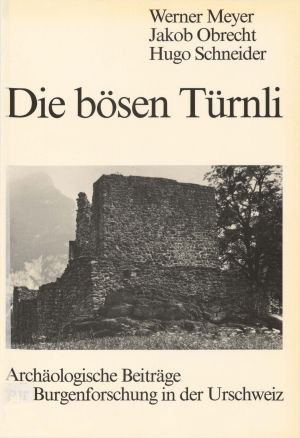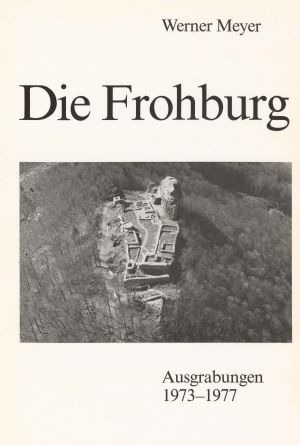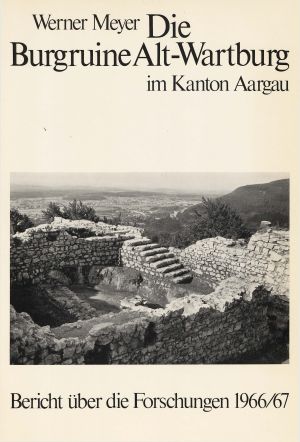Meyer, Werner
Burgenforschung in Graubünden: Berichte über die Forschungen auf den Burgruinen Fracstein und Schiedberg
Dieser Band enthält Berichte über Ausgrabungen und architektonische Untersuchungen auf der Burg Fracsteingrotte in Seewis/Prättigau bei Landquart und der Burgruine Schiedberg in Sagogn/Sagens. Er enthält auch zahlreiche Fotografien und Zeichnungen.
Die Burgruine Scheidegg bei Gelterkinden: Bericht über die Forschungen 1970–74
The Scheiddegg castle ruins lie on a wooded ridge, away from the busy flow of traffic high above the municipality of Tecknau in the upper reaches of the Ergolz Valley. Under the leadership of the Archaeology Department of Canton Basel-Landschaft, the ruin was examined in 1970–74. Based on the identifiable small finds, the construction of the castle can be dated to between 1220 and 1230. It was destroyed by a (naturally occurring) conflagration around 1320, as attested to by both a massive layer of burnt rubble and an assemblage of finds from every area of the castle inhabitants’ lives. A remarkable discovery was the skeletal remains of seven horses, which probably succumbed to the flames. From an architectural perspective, the castle’s most striking features were a large residential tower, which was reinforced by a round pillar at each corner, and a castle courtyard with a substantial filter cistern.
Das Castel Grande in Bellinzona: Bericht über die Ausgrabungen und Banuntersuchungen von 1967
The fortifications of Bellinzona are some of the most outstanding medieval defences in Switzerland. Throughout history, various forces have fought to gain ownership of the site. The marching sound of Roman legionaries was soon replaced by the cacophony of Germanic and Rhaetian hordes, before the various rulers of Italy took turns in fighting off foreign invaders. It was not until around 1500 when Bellinzona came into the ownership of the Old Swiss Confederacy that the situation became less volatile, and the fortifications gradually lost their military use.
This report does not claim to offer a complete history of the Castel Grande site, as the excavations and architectural study were limited to the south wing of the castle due to construction activities. The archaeological investigations yielded evidence of several phases of construction dating from the 4th to 11th centuries, while the examination of the walls identified elements dating from the first half of the 13th century up to the end of the 15th century. The small finds suggest that the hilltop was settled in prehistoric periods and attest to human presence from the Augustan period to the present. The high medieval finds clearly show influences from the northern foothills of the Alps (stove tiles) and from Italy (majolica). From the 13th century onwards, there was a significantly greater Lombard-Italian influence, which reached its highpoint in the 15th century, with regard to both the artefacts and the architectural design of the fortifications.
Burgen aus Holz und Stein: Burgenkundliches Kolloquium in Basel 1977
This volume contains the proceedings from a conference on castle studies held in Basel in 1977 to celebrate the 50th anniversary of the founding of the Schweizerischer Burgenverein. Looking back over half a century of the association’s existence, which has a good reputation in academic circles both here and abroad, the conference programme was intentionally wide-ranging. The contributions from various researchers in Switzerland and abroad point to the diversity of medieval defensive structures in terms of form, function and materials. The six presentations share an important leitmotif in current medieval research: interlinking archaeological features with historical contexts. The volume contains two Swiss papers; Hugo Schneider’s paper on Letzi walls (defensive barriers or boundary markers) in the Alpine region puts the spotlight on the founding period of the Old Swiss Confederacy, while Werner Mayer attempts to make an archaeological contribution to the medieval history of settlement by examining the links between castle construction, the rise of political power and forest clearance rights. Using lowland castles in the Rhineland as an example, Walter Janssen sheds light on the transition between timber construction and stone architecture in the High Middle Ages and examines the social status of individual noble lineages based on the differences in the construction of their castles. Similarly, Jacques Renaud uses 13th/14th century brick-built castles in the Netherlands to present the history of Dutch feudalism. Based on the geographic locations and types of construction of timber-built Slavic castles in north-western Germany, Karl Struve examines the social structure of the Slavic tribes. Olaf Olsen’s paper on concentric castles in Denmark provides an insight into the military and political organisation of Danish kingship at the time of the Vikings.
Die Grafen von Kyburg: Kyburger-Tagung 1980 in Winterthur
To mark the 800th anniversary of the first mention in historical records of Winterthur in 1180, the Historical Society of Winterthur held a conference on the founders of Winterthur, the Counts of Kyburg, accompanied by a small exhibition. The aim was to link the history of the locality with that of the region and beyond and, in doing so, to pay tribute to the dynasty, bearing in mind the current state of historical research and putting it in an overall context. As a consequence, the idea behind the publication was far-reaching.
The first part deals with the history of the family and its reign, studies the Dillingen roots in Swabia and Switzerland (Heinz Bühler and Adolf Layer) and critically assesses the way in which the family used their power (Roger Sablonier). The second presents the counts’ church endowments (Alfred Häberle), castles (Werner Meyer) and city foundations (Karl Keller). The third and final part is dedicated to the 1180 “town charter” of Winterthur (Ferdinand Elsener), the coins (Dietrich Schwarz) and the heraldry (Hans Kläui). The volume ends with a report on the excavations carried out at Mörsburg Castle (Jakob Obrecht), one of the counts’ residences near Winterthur.
Die bösen Türnli: Archäologische Beiträge zur Burgenforschung in der Urschweiz
This volume contains reports on the excavations and architectural investigations carried out at several castle sites in the cantons that made up the “Old Swiss Confederacy”. Six sites are presented: the castle ruins at Attinghausen, Seedorf, Zwing Uri, Gesslerburg, Schanau and Landenberg above Sarnen. The final chapter by Werner Meyer deals with the construction and demolition of castles in the region that is considered to have constituted the “Old Swiss Confederacy”. The book also contains numerous photographs and drawings.
Die Frohburg: Ausgrabungen 1973-1977
The excavations carried out between 1973 and 1977 were the third attempt at examining Frohburg Castle by archaeological means. In this volume Werner Meyer outlines the course and results of the excavations. The first chapter on the history of research is followed by an analysis of the features excavated and the small finds recovered. The written records provide additional important insight. The final chapter presents the results of the examinations. The topics discussed include the history of construction and settlement, the economic and social history and, finally, the castle typology.
Die Burgruine Alt-Wartburg im Kanton Aargau: Bericht über die Forschungen 1966/67
In 1966/67, the ruins of Alt-Wartburg above Olten were cleared of rubble and archaeologically examined. One of the interesting aspects from a research point of view is a terminus ante quem for the castle’s destruction, which is mentioned several times in records for the year 1415. Finds and features suggest that the settlement was founded in the 11th century. The preserved walls date from the 12th century, followed by a phase of expansion in the second half of the 13th century; further structural alterations were carried out in the 14th century. In 1415, the castle was seized, pillaged and destroyed by fire during the conquest of the Aargau region by the Bernese. The spectrum of finds does not show the entire range of household goods typically found at a medieval castle site, since items that could easily be carried off were probably looted in 1415. This makes the series of stove tiles found all the more impressive, ranging from unglazed beaker tiles to vessel tiles and medallion tiles as well as accessories such as cornice tiles and upper cornice tiles. But even here the rampaging of the conquerors was evident: hardly any of the medallions were completely preserved, and most were smashed. The detailed presentation of the archaeological context is followed by a chapter on the history of ownership and political power.
Die Burg Zug: Archäologie – Baugeschichte – Restaurierung
During its 800-year existence, Zug Castle went through many changes. Construction of a large section of the architectural complex still in existence today began in the 12th century. Built originally as a manorial seat, it evolved into a residence in the Late Middle Ages and eventually became an historical museum in the 20th century.
Between 1967 and 1982, archaeological excavations took place in the castle grounds and an extensive architectural survey of the building itself was also carried out. Post-excavation work painted a surprisingly detailed picture of this extraordinary building, the importance of which radiated beyond the boundaries of Canton Zug. The main themes of the publication include the results from the excavations and architectural surveys as well as the archaeological finds recovered. Other topics are the restoration of the building and the exhibition concept of the “Museum at the Castle”.



